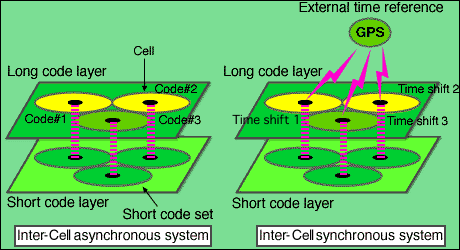W-CDMA Technology Supporting Third-Generation Mobile Communications System -5.Dual-Spread Codes and Inter-cell Asynchronous
The W-CDMA system adopts a dual-spread code arrangement, which uses an almost infinite number of spectrum-spread codes, generated by the combination of symbol-length "spread codes" and multiple-symbol-length "scrambling codes." This makes it possible to freely carry out channel arrangement for each cell.
While GPS synchronization of chip levels is normally required between cells in systems in which each cell uses the same scrambling code and changes the code phase, it is not necessary to adopt inter-cell synchronization in this system. As a result, usage both indoors -- where it is difficult to apply GPS -- and outdoors can be seamlessly supported.
In the W-CDMA system, channels can be designated through a combination of the spread and scrambling codes. As different scrambling codes for each cell are used in the downlink from the base station to the portable unit, the same set of spectrum-spread codes can be used for channel assignment between different cells.
In the case of the uplink, the switchover in spread codes at hand-over becomes unnecessary as different scrambling codes can be used for each user, and orthogonal-spread codes can be used for orthogonal multi-rate transmissions.

Inter-Cell Asynchronous System
![]() Created 1999/03
Created 1999/03
